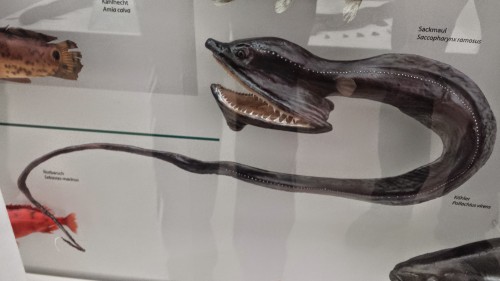Construction of the Phyletisches Museum in Jena, Germany began on Goethe’s birthday on August 28, 1907. The Art Nouveau-styled museum was devised by the great evolutionary biologist, embryologist and artist/howthefuckdoyousummarizehowcoolhewas Ernst Haeckel, who by that time had earned fame in many areas of research (and art), including coining the terms ontogeny (the pattern of development of an organism during its lifetime) and phylogeny (the pattern of evolution of lineages of organisms through time) which feature prominently in the building’s design and exhibits (notice them intertwined in the tree motif below, on the front of the museum). Ontogeny and phylogeny, and the flamboyant artistic sensibility that Haeckel’s work exuded, persist as themes in the museum exhibits themselves. Haeckel also came up with other popular words such as Darwinism and ecology, stem cell, and so on… yeah the dude kept busy.
I first visited the Phyletisches Museum about 10 years ago, then again this August. Here are the sights from my latest visit: a whirlwind ~20 minute tour of the museum before we had to drive off to far-flung Wetzlar. All images are click-tastic for embiggenness.
Stomach-Churning Rating: 3/10 for some preserved specimens. And art nouveau.

Phylogeny of Deuterostomia (various wormy things, echinoderms, fish and us), illustrated with lovely artistry.

On into tetrapods– a Fire Salamander (Salamandra salamandra)! We love ‘em, and the museum had several on display- given that we were studying them with x-rays, seeing the skeleton and body together here in this nice display was a pleasant surprise.

In a subtle nod to recurrent themes in evolution, the streamlined bodies of an ichthyosaur and cetacean shown in the main stairwell of the museum, illustrating convergent evolution to swimming adaptations.

Gnarly model of an Archaeopteryx looks over a cast of the Berlin specimen, and a fellow archosaur (crocodile). The only extinct dinosaur on exhibit!

Kiwi considers the differences in modern bird palates: palaeognathous like it and fellow ratites/tinamous (left), and neognathous like most living birds.

Hyraxes, which Prof. Martin Fischer, longtime curator of the Phyletisches Museum, has studied for many years. Rodent-like elephant cousins.

Old exhibit at the Phyletisches Museum, now gone: Forelimbs of an elephant posed in the same postures actually measured in African elephants, for the instant of foot touchdown (left pic) and liftoff (right pic). Involving data that we published in 2008!

Eek, primates! Gorilla see, gorilla do. Notice the primitive “bent hip, bent knee” vs. the advanced “upright modern human” hindlimb postures in the two non-skeletal hominids.

Carved shoulderblade (scapula) of a bowhead whale (Balaena mysticetus), which apparently Goethe owned (click to emwhalen and read the fine print). Quite a relic!

One of Haeckel’s residences, across the street from the museum. There is also a well-preserved house of his that one can visit, but I didn’t make it there. I heard it’s pretty cool.
Jena is tucked away in a valley in former East Germany, with no local airport for easy access- but get to Leipzig and take a 1.25 hour train ride and you’re there. Worth a trip! This is where not just ontogeny and phylogeny were “born”, but also morphology as a modern, rigorous discipline. Huge respect is due to Jena, and to Haeckel, whose quotable quotes and influential research still resonate today, in science as well as in art.





































